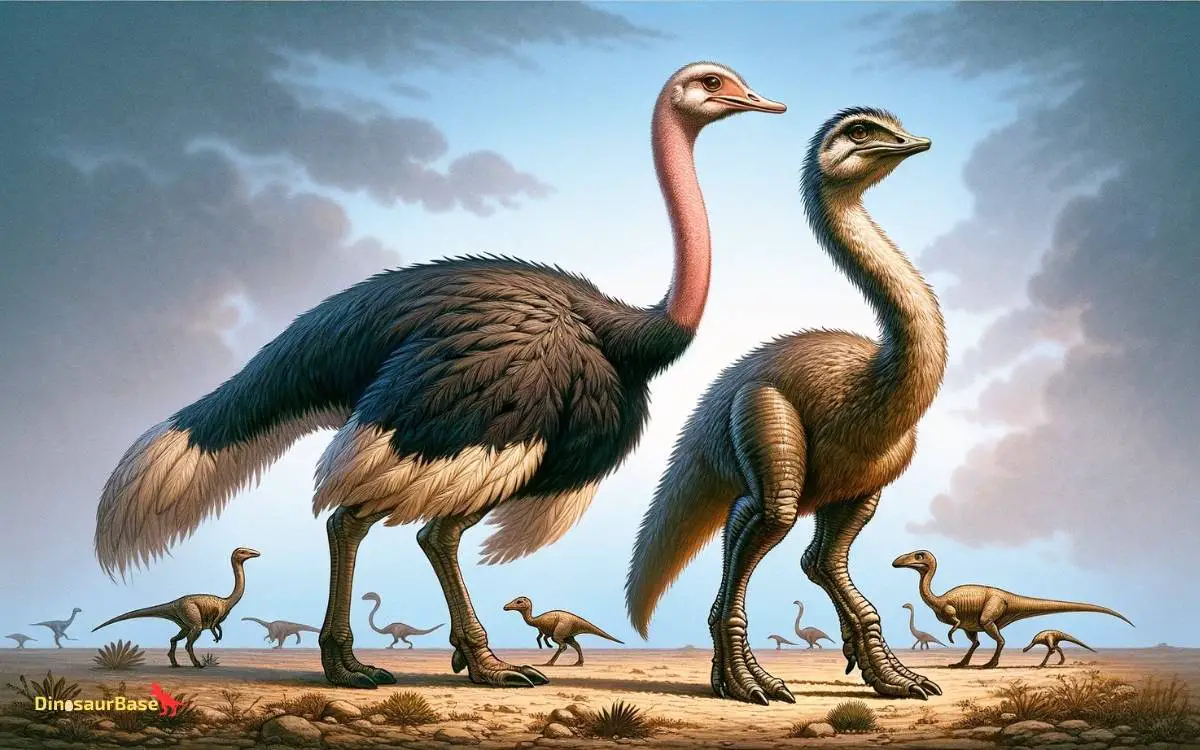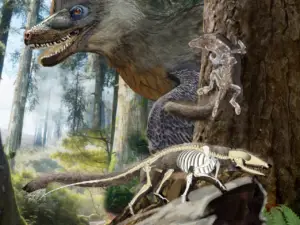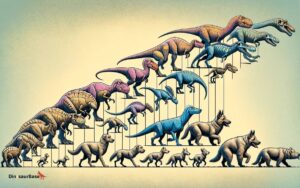How to Trace the Ostrich Lineage Back to Dinosaurs
To trace the ostrich lineage back to dinosaurs, examine their modern bird characteristics and fossil records. Genetic research and paleontology provide the clearest evidence of their ancient ancestry.
Exploring the connection between ostriches and dinosaurs reveals a fascinating journey through time. As the largest living birds on Earth, ostriches offer a unique glimpse into the prehistoric world, bridging a gap spanning millions of years.
Scientists utilize DNA analysis and comparative anatomy to unearth the evolutionary path of these flightless birds.
Through the study of well-preserved fossils, particularly theropod dinosaurs, researchers can identify morphological similarities shared between these ancient creatures and modern ostriches.
This investigation not only enriches our understanding of biological evolution but also sheds light on the survival and adaptation strategies that have allowed ostriches to thrive in diverse environments.
As a marvel of evolutionary history, the ostrich lineage serves as an extraordinary example of the enduring legacy of dinosaurs in today’s avian species.

The Ostrich-dinosaur Connection
Imagine a creature with long legs sprinting across ancient landscapes. This image brings to mind the majestic ostriches of our time, but it also echoes the movements of their prehistoric predecessors—dinosaurs.
The link between ostriches and dinosaurs is a tale of survival and evolution. It is a fascinating journey from the prehistoric jungles to modern savannas.
Unraveling the lineage of these incredible birds reveals the deep-rooted legacy of dinosaurs alive today.
Bridging Modern Birds And Ancient Reptiles
Scientists study fossils and DNA to connect ostriches to dinosaurs. Contained within the genes of modern birds lie secrets from millions of years ago.
Birds, like ostriches, are the only living relatives of theropod dinosaurs. This group includes the fierce Tyrannosaurus rex and the swift Velociraptor.
The ostrich is a key species in understanding this evolutionary bridge. It is one of the closest avian connections we have to these ancient reptiles.
Physical Similarities: Claws, Stance, And Gait
Ostriches and theropod dinosaurs share distinct physical traits. These similarities provide clear evidence of their shared lineage. Let’s look at some of these traits:
- Claws: Both have powerful claws on their feet. These are reminiscent of their reptilian ancestors.
- Stance: The upright stance is another common feature. It reflects a bipedal mode of movement.
- Gait: Observing an ostrich run reveals a powerful two-legged gait. This gait closely mirrors that of theropod dinosaurs.
Scientists use advanced technology to study these characteristics. They compare fossilized footprints and digital reconstructions to prove the connection. The more we learn about ostriches, the more we understand their dinosaurian heritage.
These birds do not just walk. They stride through the world as living testaments to their mighty ancestors.

Credit: www.science.org
Evidence From The Fossil Record
The past whispers secrets through fossils, and these ancient relics tell tales of life long extinct. A lineage that stretches back millions of years connects the modern ostrich to its dinosaur ancestors.
Paleontologists uncover the links piece by piece, like a puzzle unveiling the grand picture of evolution.
Fossils serve as crucial evidence, allowing us to peer back into a world where dinosaurs reigned supreme.
Discoveries Of Feathered Dinosaurs
Fossils with feathers reveal dinosaurs that looked much like birds. Here are key discoveries:
- Archaeopteryx: Often cited as the first bird, it showcases a blend of avian and reptilian features.
- Velociraptor: Known for its role in movies, real fossils show quill knobs, indicating feathers.
- Yutyrannus: This massive feathered dinosaur suggests even large dinosaurs sported feathers.
Such fossils highlight a transition from scaly hides to modern feathers. This suggests a shared ancestry with birds.
Analyzing Fossilized Ostrich Relatives
Fossils of ancient birds resembling ostriches offer more clues:
- Diatryma: With a towering frame, some debated if it was a predator, but recent analysis leans towards herbivore.
- Palaeotis: Lived in the Eocene epoch and shared many features with young ostriches.
Studying fossils helps scientists trace back the ostrich’s roots. Bird fossils next to dinosaur-era remains suggest kinship through time.
Genetic Insights
The quest to trace the majestic ostrich back to its ancient relatives uncovers a fascinating journey.
Ostriches share a lineage with creatures from the Mesozoic era. Genetic insights provide a map to this remarkable evolutionary path.
Decoding The Avian Dna
Unraveling the DNA of modern birds illuminates the past. Ostrich DNA holds many secrets dating back millions of years.
Scientists pull data from bones, feathers, and eggs. They analyze sequences to find connections to the dinosaurs. DNA decoding goes like this:
- Extract DNA from ostrich samples.
- Sequence the genome using advanced technology.
- Identify genes similar to those in ancient species.
- Build a genetic map linking birds to dinosaurs.
Comparing Genetic Markers
Genetic markers work as breadcrumbs back in time. Researchers compare ostrich genes to those in fossil records. Here’s what they look for:
| Marker | Ostrich | Dinosaur Ancestor |
|---|---|---|
| Protein Codes | Similar structures | Shared traits |
| Mutation Rates | Low variability | Comparable patterns |
| Chromosome Layout | Complex arrangement | Common organization |
Each match paints a clearer picture of their ancient relatives, bridging the gap. Ostriches do not just walk the earth; they carry the tale of a bygone era in every cell.
Evolutionary Biology Of Birds
The world of birds is a tapestry woven deep into the history of the Earth, showcasing a story of evolution, adaptation, and the survival of the fittest.
An astonishing member of this story, the ostrich, offers scientists key insights into a lineage that connects the dots back to the age of dinosaurs.
When we dive into the Evolutionary Biology of Birds, we uncover their journey through time, starting with their ancient ancestors, the theropods, leading us to the remarkable existence of ostriches and other flightless birds today.
The Rise Of Theropods
Understanding the avian family tree begins with the theropods. These fierce, two-legged dinosaurs roamed the Earth millions of years ago. Key characteristics shared with modern birds include:
- Lightweight, hollow bones
- Furcula (wishbone), which strengthened the thoracic skeleton
- Three-toed limbs
Remarkably, fossils of theropods such as Velociraptor and Tyrannosaurus rex have showcased evidence of feathers. This discovery reinforces the direct link between them and the birds we see today.
Ostriches And The Lineage Of Flightless Birds
Ostriches, with their towering height and flightless form, are part of a group known as Ratites. These birds evolved with a flat breastbone, lacking the keel that supports the powerful flight muscles in birds like eagles and sparrows.
Let’s analyze some intriguing aspects:
| Characteristic | Function |
|---|---|
| Powerful Legs | Compensating for lack of flight with speed |
| Large Size | Deterrence of predators |
| Reduced Wings | Balancing during fast runs |
Their DNA tells an old story, dating back to the supercontinent of Gondwana. As it split, so did the ancestors of ostriches, adapting to their environments, which led to different flightless birds around the world.
Scientists study these magnificent creatures, tracing elements of their DNA that hold ancestral secrets, leading all the way back to their dinosaur forebears.
Paleontology And Modern Technology
Paleontology once relied solely on fossil digs and physical reconstructions. Today, scientists use cutting-edge tools.
These tools reveal secrets locked in ancient bones. Looking back millions of years, we trace the ostrich lineage to its dinosaur ancestors.
Ct Scans And 3d Modeling
CT scans offer a non-destructive way to peek inside fossils. Complex internal structures become visible without harming the fossil. Researchers discover links between modern birds like ostriches and prehistoric creatures.
- Bone density and texture analysis
- Soft tissue and organ visualization
- Muscle attachment insight
Revolutionizing The Understanding Of Extinct Species
3D modeling takes understanding further. We build detailed reconstructions from CT data. Models simulate behavior and movement. Insights into the evolution from dinosaurs to ostriches are clearer.
- Models show how ostrich ancestors moved.
- Feathers and other soft parts take shape.
- Digital simulations test theories of evolution.

Credit: www.sci.news
Frequently Asked Questions For How To Trace The Ostrich Lineage Back To Dinosaurs
How Are Ostriches Related To Dinosaurs?
Ostriches are modern birds that share a common ancestor with dinosaurs. They are descendants from theropod dinosaurs, similar to the lineage that led to Tyrannosaurus rex.
What Is The Ostrich Dinosaur Descendant?
The ostrich dinosaur is commonly known as Struthiomimus, a theropod dinosaur known for its striking resemblance to modern ostriches.
Are Velociraptors Ancestors Of Ostriches?
Velociraptors are not direct ancestors of ostriches. Ostriches descend from a different line of dinosaurs than velociraptors. Both share a common avian ancestor further back in the evolutionary tree.
What Is The Closest Descendant To Dinosaurs?
Birds are the closest living descendants of dinosaurs, specifically from the theropod group.
Conclusion
Tracing the ostrich lineage reveals a fascinating journey back to their dinosaur ancestors. Scientific research and fossil records have connected the dots from ancient to modern times.
This exploration not only enriches our understanding of evolution but also showcases the enduring legacy of these magnificent creatures.
Embrace this knowledge, and let the past enhance your appreciation of ostriches today.





